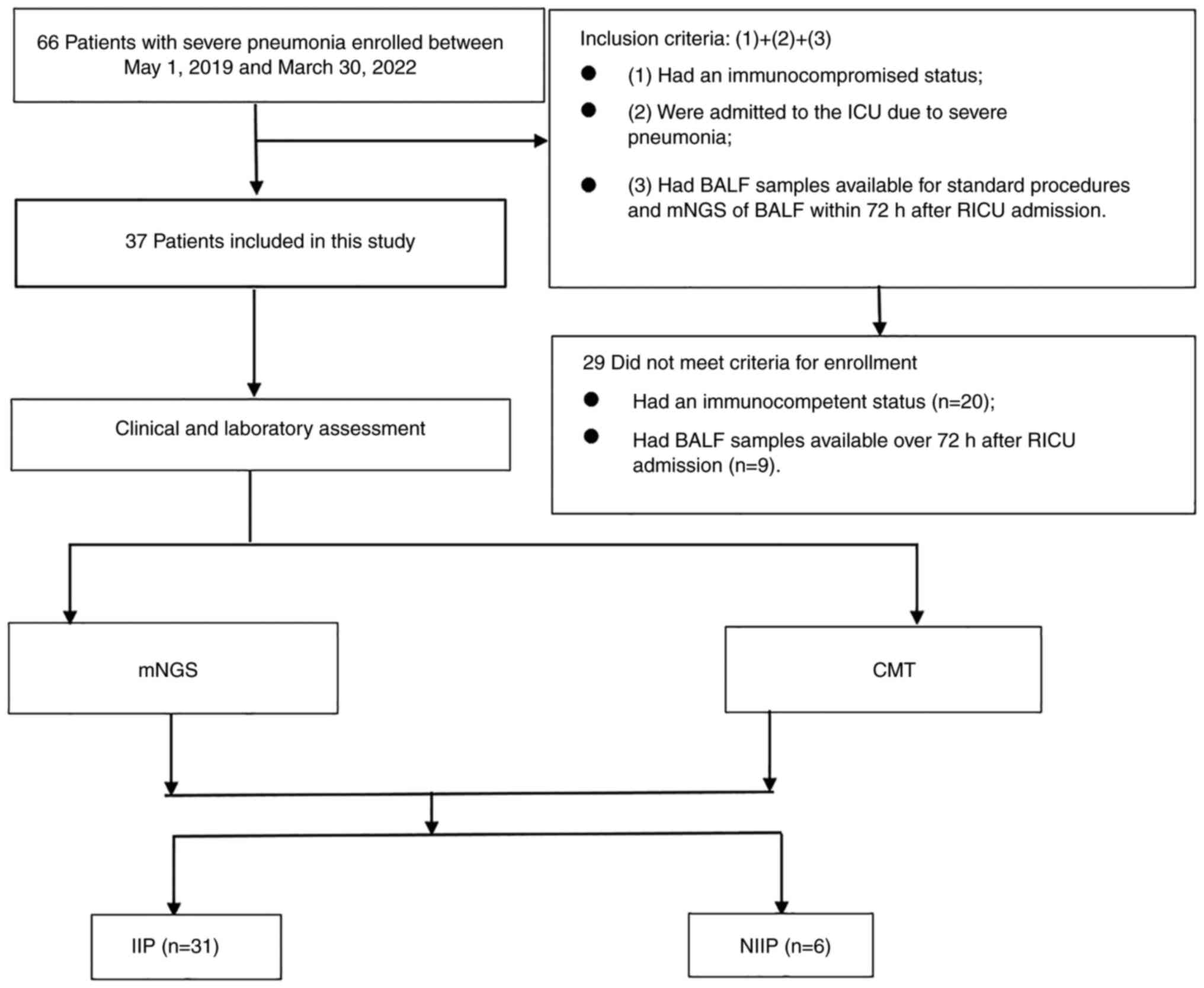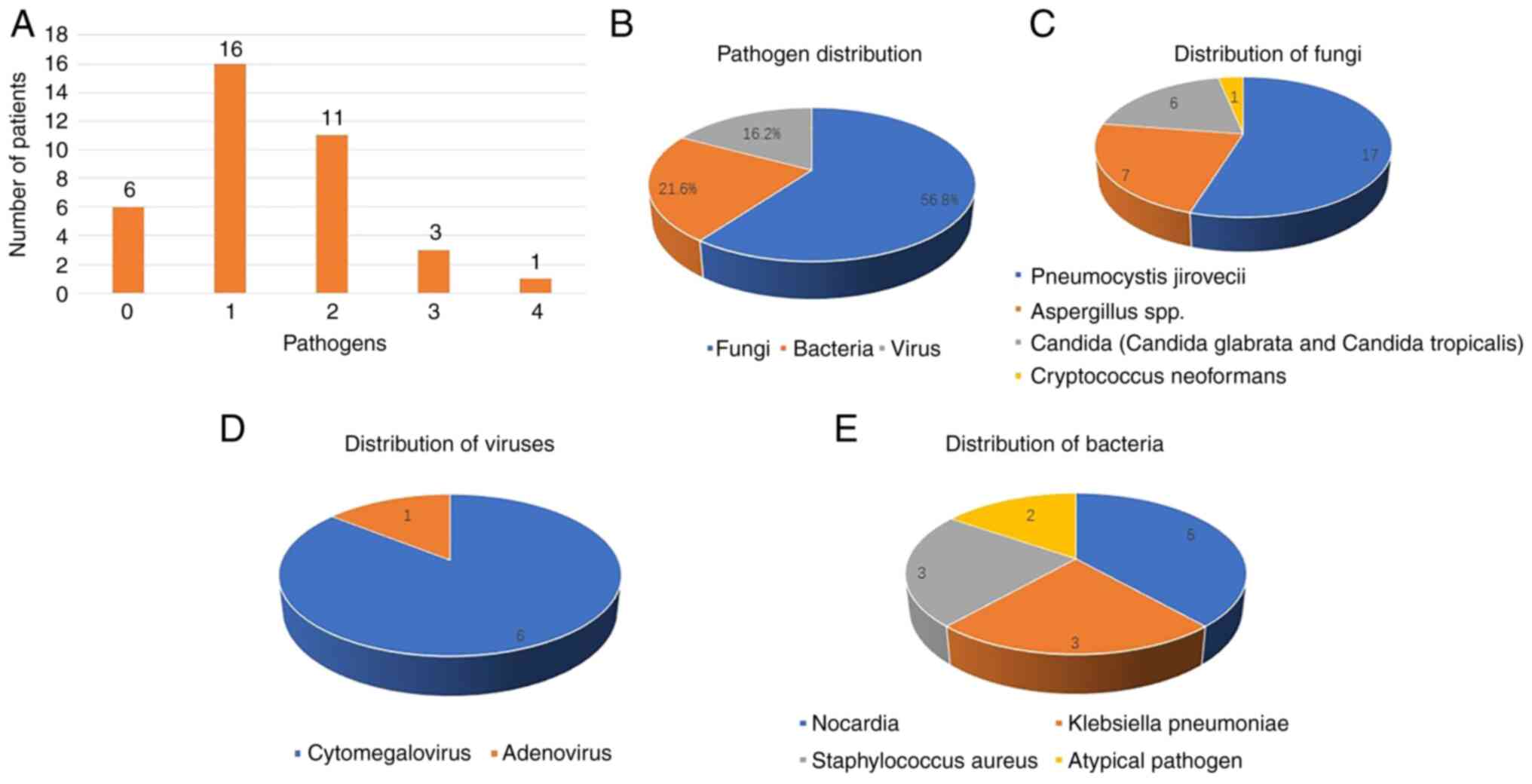|
1
|
Spasovska K, Grozdanovski K, Milenkovic Z,
Bosilkovski M, Cvetanovska M, Kuzmanovski N, Kapsarov K and
Atanasovska E: Evaluation of severity scoring systems in patients
with severe community acquired pneumonia. Rom J Intern Med.
59:394–402. 2021.PubMed/NCBI View Article : Google Scholar
|
|
2
|
Qu J, Zhang J, Chen Y, Huang Y, Xie Y,
Zhou M, Li Y, Shi D, Xu J, Wang Q, et al: Etiology of severe
community acquired pneumonia in adults identified by combined
detection methods: A multi-center prospective study in China. Emerg
Microbes Infect. 11:556–566. 2022.PubMed/NCBI View Article : Google Scholar
|
|
3
|
Lopardo GD, Fridman D, Raimondo E,
Albornoz H, Lopardo A, Bagnulo H, Goleniuk D, Sanabria M and
Stamboulian D: Incidence rate of community-acquired pneumonia in
adults: A population based prospective active surveillance study in
three cities in South America. BMJ. 8(e019439)2018.PubMed/NCBI View Article : Google Scholar
|
|
4
|
Quah J, Jiang B, Tan PC, Siau C and Tan
TY: Impact of microbial Aetiology on mortality in severe
community-acquired pneumonia. BMC Infect Dis.
18(451)2018.PubMed/NCBI View Article : Google Scholar
|
|
5
|
Wu XJ, Gu SC, Cai Y, Zhai TS and Zhan QY:
Etiology of severe community-acquired pneumonia in
immunocompromised patients. Zhonghua Jie He He Hu Xi Za Zhi.
44:892–896. 2021.PubMed/NCBI View Article : Google Scholar : (In Chinese).
|
|
6
|
Montull B, Menendez R, Torres A, Reyes S,
Mendez R, Zalacain R, Capelastegui A, Rajas O, Borderías L,
Martin-Villasclaras J, et al: Predictors of severe sepsis among
patients hospitalized for community-acquired pneumonia. PLoS One.
11(e0145929)2016.PubMed/NCBI
|
|
7
|
Ewig S, Birkner N, Strauss R, Schaefer E,
Pauletzki J, Bischoff H, Schraeder P, Welte T and Hoeffken G: New
perspectives on community-acquired pneumonia in 388 406 patients.
Results from a nationwide mandatory performance measurement
programme in healthcare quality. Thorax. 64:1062–1069.
2009.PubMed/NCBI View Article : Google Scholar
|
|
8
|
Miao Q, Ma Y, Wang Q, Pan J, Zhang Y, Jin
W, Yao Y, Su Y, Huang Y, Wang M, et al: Microbiological diagnostic
performance of metagenomic next-generation sequencing when applied
to clinical practice. Clin Infect Dis. 67 (Suppl 2):S231–S240.
2018.PubMed/NCBI View Article : Google Scholar
|
|
9
|
Gu W, Miller S and Chiu CY: Clinical
metagenomic next-generation sequencing for pathogen detection. Annu
Rev Pathol. 14:319–338. 2019.PubMed/NCBI View Article : Google Scholar
|
|
10
|
Simnera PJ, Miller S and Carroll KC:
Understanding the promises and hurdles of metagenomic
next-generation sequencing as a diagnostic tool for infectious
diseases. Clin Infect Dis. 66:778–788. 2018.PubMed/NCBI View Article : Google Scholar
|
|
11
|
Wilson MR, O'Donovan BD, Gelfand JM,
Sample HA, Chow FC, Betjemann JP, Shah MP, Richie MB, Gorman MP,
Hajj-Ali RA, et al: Chronic meningitis investigated via metagenomic
next-generation sequencing. JAMA Neurol. 75:947–955.
2018.PubMed/NCBI View Article : Google Scholar
|
|
12
|
Goldberg B, Sichtig H, Geyer C, Ledeboer N
and Weinstock GM: Making the leap from research laboratory to
clinic: Challenges and opportunities for next-generation sequencing
in infectious disease diagnostics. MBio. 6:e01888–e018815.
2015.PubMed/NCBI View Article : Google Scholar
|
|
13
|
Schlaberg R, Chiu CY, Miller S, Procop GW
and Weinstock G: Professional Practice Committee and Committee on
Laboratory Practices of the American Society for Microbiology;
Microbiology Resource Committee of the College of American
Pathologists. Validation of metagenomic next-generation sequencing
tests for universal pathogen detection. Arch Pathol Lab Med.
141:776–786. 2017.PubMed/NCBI View Article : Google Scholar
|
|
14
|
Wilson MR, Sample HA, Zorn KC, Arevalo S,
Yu G, Neuhaus J, Federman S, Stryke D, Briggs B, Langelier C, et
al: Clinical metagenomic sequencing for diagnosis of meningitis and
encephalitis. N Engl J Med. 380:2327–2340. 2019.PubMed/NCBI View Article : Google Scholar
|
|
15
|
Simner PJ, Miller HB, Breitwieser FP,
Pinilla Monsalve G, Pardo CA, Salzberg SL, Sears CL, Thomas DL,
Eberhart CG and Carroll KC: Development and optimization of
metagenomic next-generation sequencing methods for cerebrospinal
fluid diagnostics. J Clin Microbiol. 56:e00472–18. 2018.PubMed/NCBI View Article : Google Scholar
|
|
16
|
Zhang Y, Ai JW, Cui P, Zhang WH, Wu HL and
Ye MZ: A cluster of cases of pneumocystis pneumonia identified by
shotgun metagenomics approach. J Infect. 78:158–169.
2019.PubMed/NCBI View Article : Google Scholar
|
|
17
|
Pan T, Tan R, Qu H, Weng X, Liu Z, Li M
and Liu J: Next-generation sequencing of the BALF in the diagnosis
of community-acquired pneumonia in immunocompromised patients. J
Infect. 79:61–74. 2019.PubMed/NCBI View Article : Google Scholar
|
|
18
|
Blauwkamp TA, Thair S, Rosen MJ, Blair L,
Lindner MS, Vilfan LD, Kawli T, Christians FC, Venkatasubrahmanyam
S, Wall GD, et al: Analytical and clinical validation of a
microbial cell-free DNA sequencing test for infectious disease. Nat
Microbiol. 4:663–674. 2019.PubMed/NCBI View Article : Google Scholar
|
|
19
|
Ivy MI, Thoendel MJ, Jeraldo PR,
Greenwood-Quaintance KE, Hanssen AD, Abdel MP, Chia N, Yao JZ,
Tande AJ, Mandrekar JN and Patel R: Direct detection and
identification of prosthetic joint infection pathogens in synovial
fluid by metagenomic shotgun sequencing. J Clin Microbiol.
56:e00402–18. 2018.PubMed/NCBI View Article : Google Scholar
|
|
20
|
Burnham P, Dadhania D, Heyang M, Chen F,
Westblade LF, Suthanthiran M, Lee JR and De Vlaminck I: Urinary
cell-free DNA is a versatile analyte for monitoring infections of
the urinary tract. Nat Commun. 9(2412)2018.PubMed/NCBI View Article : Google Scholar
|
|
21
|
Cao B, Huang Y, She DY, Cheng QJ, Fan H,
Tian XL, Xu JF, Zhang J, Chen Y, Shen N, et al: Diagnosis and
treatment of community-acquired pneumonia in adults: 2016 clinical
practice guidelines by the Chinese Thoracic Society, Chinese
Medical Association. Clin Respir J. 12:1320–1360. 2018.PubMed/NCBI View Article : Google Scholar
|
|
22
|
Peng JM, Du B, Qin HY, Wang Q and Shi Y:
Metagenomic next-generation sequencing for the diagnosis of
suspected pneumonia in immunocompromised patients. J Infect.
82:22–27. 2021.PubMed/NCBI View Article : Google Scholar
|
|
23
|
Chen X, Ding SZ, Lei C, Qin JL, Guo T,
Yang DH, Yang M, Qing J, He WL, Song M, et al: Blood and
bronchoalveolar lavage fluid metagenomic next-generation sequencing
in pneumonia. Can J Infect Dis Med Microbiol.
2020(6839103)2020.PubMed/NCBI View Article : Google Scholar
|
|
24
|
Li Y, Sun B, Tang X, Liu YL, He HY, Li XY,
Wang R, Guo F and Tong ZH: Application of metagenomic
next-generation sequencing for bronchoalveolar lavage diagnostics
in critically ill patients. Eur J Clin Microbiol Infect Dis.
39:369–374. 2020.PubMed/NCBI View Article : Google Scholar
|
|
25
|
Zhang P, Chen Y, Li S, Li C, Zhang S,
Zheng W, Chen Y, Ma J, Zhang X, Huang Y and Liu S: Metagenomic
next-generation sequencing for the clinical diagnosis and prognosis
of acute respiratory distress syndrome caused by severe pneumonia:
A retrospective study. PeerJ. 8(e9623)2020.PubMed/NCBI View Article : Google Scholar
|
|
26
|
Phua J, Ngerng W, See K, Tay C, Kiong T,
Lim H, Chew M, Yip H, Tan A, Khalizah H, et al: Characteristics and
outcomes of culture-negative versus culture-positive severe sepsis.
Crit Care. 17(R202)2013.PubMed/NCBI View
Article : Google Scholar
|
|
27
|
Han D, Li Z, Li R, Tan P, Zhang R and Li
JM: mNGS in clinical microbiology laboratories: On the road to
maturity. Crit Rev Microbiol. 45:668–685. 2019.PubMed/NCBI View Article : Google Scholar
|
|
28
|
Duan H, Li X, Mei A, Li P, Liu Y, Li X, Li
W, Wang C and Xie S: The diagnostic value of metagenomic
next-generation sequencing in infectious diseases. BMC Infect Dis.
21(62)2021.PubMed/NCBI View Article : Google Scholar
|
|
29
|
Grumaz S, Stevens P, Grumaz C, Decker SO,
Weigand MA, Hofer S, Brenner T, von Haeseler A and Sohn K:
Next-generation sequencing diagnostics of bacteremia in septic
patients. Genome Med. 8(73)2016.PubMed/NCBI View Article : Google Scholar
|
|
30
|
Abril MK, Barnett AS, Wegermann K,
Fountain E, Strand A, Heyman BM, Blough BA, Swaminathan AC,
Sharma-Kuinkel B, Ruffin F, et al: Diagnosis of capnocytophaga
canimorsus sepsis by whole-genome next-generation sequencing. Open
Forum Infect Dis. 3(ofw144)2016.PubMed/NCBI View Article : Google Scholar
|
|
31
|
Wu X, Li Y, Zhang M, Li M, Zhang R, Lu X,
Gao W and Li Q, Xia Y, Pan P and Li Q: Etiology of Severe
community-acquired pneumonia in adults based on metagenomic
next-generation sequencing: A prospective multicenter study. Infect
Dis Ther. 9:1003–1015. 2020.PubMed/NCBI View Article : Google Scholar
|
|
32
|
Sun T, Wu X, Cai Y, Zhai T, Huang L, Zhang
Y and Zhan Q: Metagenomic next-generation sequencing for pathogenic
diagnosis and antibiotic management of severe community-acquired
pneumonia in immunocompromised adults. Front Cell Infect Microbiol.
11(661589)2021.PubMed/NCBI View Article : Google Scholar
|
|
33
|
Griffiths P and Reeves M: Pathogenesis of
human cytomegalovirus in the immunocompromised host. Nat Rev
Microbiol. 19:759–773. 2021.PubMed/NCBI View Article : Google Scholar
|
|
34
|
Lee ARYB, Wong SY, Chai LYA, Lee SC, Lee
MX, Muthiah MD, Tay SH, Teo CB, Tan BKJ, Chan YH, et al: Efficacy
of covid-19 vaccines in immunocompromised patients: Systematic
review and meta-analysis. BMJ. 376(e068632)2022.PubMed/NCBI View Article : Google Scholar
|
|
35
|
Fulkerson HL, Nogalski MT,
Collins-McMillen D and Yurochko AD: Overview of human
cytomegalovirus pathogenesis. Methods Mol Biol. 2244:1–18.
2021.PubMed/NCBI View Article : Google Scholar
|
|
36
|
Bateman CM, Kesson A, Powys M, Wong M and
Blyth E: Cytomegalovirus infections in children with primary and
secondary immune deficiencies. Viruses. 13(2001)2021.PubMed/NCBI View Article : Google Scholar
|
















